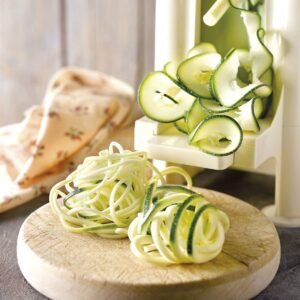There is no excuse for not presenting your vegetables in the most original ways. These utensils for cutting, emptying, spiraling or making fake rice are the ultimate in healthy and creative cooking.
There are more and more devices to enjoy vegetables like never before and add originality to our menus. And the thing is that before, with a good knife, a wooden board and a bit of technique, we made cuts like julienne, brunoised, planter or mirepoix. Now it is simpler and more varied, because there are utensils that transform vegetables like we had not seen before: such as vegetable spaghetti, lasagna plates or even grains that look like rice.
With so many alternatives, doubts can arise when choosing one cutting device or another. Well, the choice will depend on whether we are really going to use the device in question, so that it does not become another junk that collects dust in the closet. Ask yourself:
- What types of cuts and recipes do I want to make?
- Do I have space to save it?
- It’s easy to use?
Also look at the materials. In this selection we prioritize toxic-free utensils and “BPA free” plastics.
1. MULTIPURPOSE MANDOLINS
The mandolin is a classic, but it has been renewed in types of blade, materials and uses. In addition to very thin slices – you can make almost transparent pineapple slices to make capriccios – you can turn a zucchini or aubergine cut lengthwise into cannelloni plates for your baked or raw vegan preparations, as in this recipe for aubergine gutters.
When choosing them you can take into account some tips:
- We especially recommend ceramic cutting blade mandolins. This material retards the oxidation of food and is very resistant: it maintains its sharpness up to ten times more than steel. It also does not transfer its taste or smell to food.
- There are mandolins with different cutting thicknesses and with different blades to make drawings or marks on food or use them with other functions such as grating.
- There are also specific mandolins for cabbage or bulky vegetables, to cut them finely quickly and with little effort.
It is an ideal utensil to prepare coleslaw, red cabbage salad or fermented as sauerkraut or kimchi. Of course, it is advisable to use them with a finger protector and a lot of caution, so that they do not become mini guillotines.
- We recommend: Schmitt beech mandolin, with 3 blades and ideal for kale and kimchi vegetables.
2. SAW OR JULIENNE PEELERS
Potato peelers have also been in kitchen drawers for decades, but the family has expanded with saw peelers ideal for soft or slippery foods, such as ripe tomatoes, peaches …, or even for very hard foods, such as sweet potatoes. The wavy edge grips the skin very well.
The newest in peelers are the julienne ones because they turn a zucchini or carrot into thin and elongated strips to delight your salads, sautéed vegetables or garnishes. These peelers are small, practical and inexpensive, although they do not achieve a perfect spaghetti cut like the spirilizers.
3. SPIRALIZER TO MAKE “SPAGHETTI”
Spiralizers are the kings of the new devices. With them you can prepare vegetable or fruit spaghetti in no time. Zucchini spaghetti sounds familiar to you, but you can also make them with beets, carrots, turnip potatoes, parsnips, cucumbers, pear, apples…
There are many “spiralizable” foods. They serve you as a salad, garnish, single dish or even dessert. In addition, these types of recipes are ideal for children. It’s one of the easiest ways for kids and some anti-veg adults to eat greener.
When choosing a spiralizer, keep in mind that:
- There are manual or electric ones with little effort, small or bulky, single cut or 3 types of cut (thin, thick and spiral spaghetti), but they all manage to delight pasta lovers in a vegetable version, gluten free and .
- In the case of these devices, size matters. The family of spirilizers is the widest of the new gadgets and to choose one or the other we must bear in mind that in the small models only vegetables of the thickness of their diameter can fit.
A trick. Zucchini spaghetti can be used raw, cooked, baked, or sautéed. But if you want your raw zucchini to appear cooked, leave them in a colander over a bowl, add sea salt, and let them drain for about 20 minutes. They will release water and be softer, with a texture like cooked.
